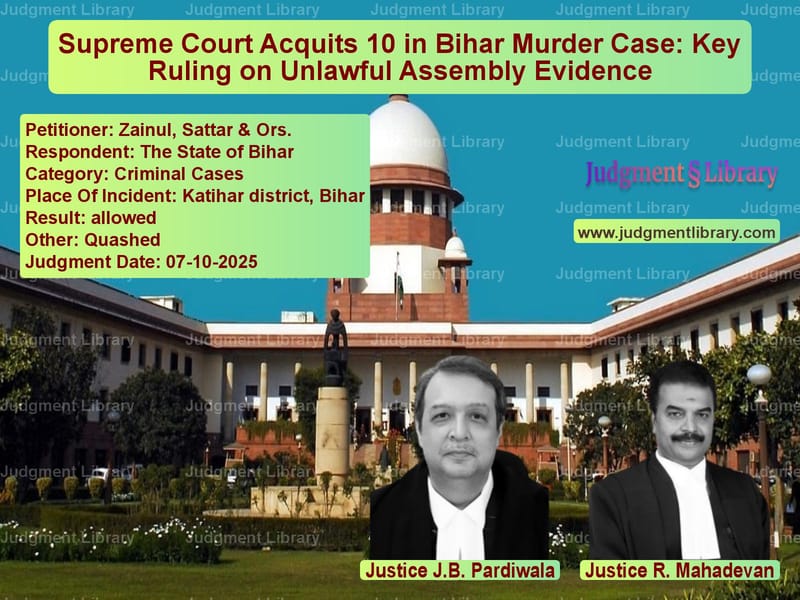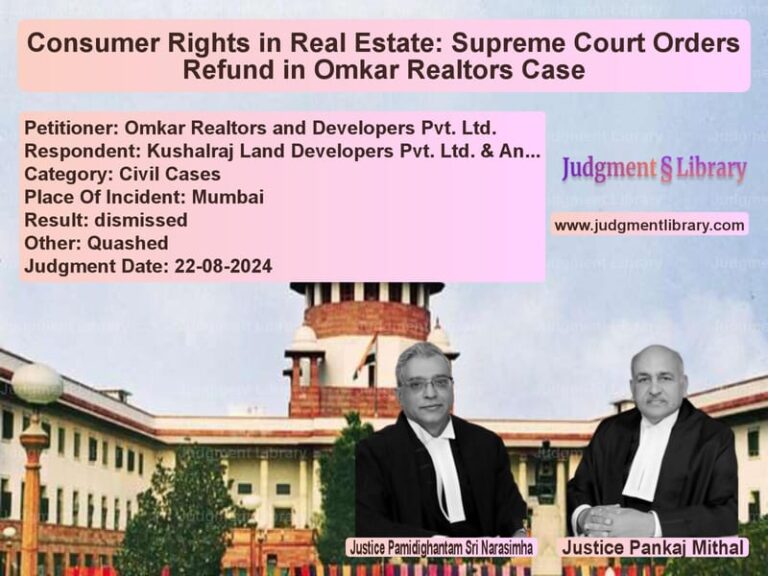Supreme Court Acquits 10 in Bihar Murder Case: Key Ruling on Unlawful Assembly Evidence
In a significant judgment that underscores the importance of careful evidence evaluation in criminal cases involving multiple accused, the Supreme Court of India has acquitted ten individuals convicted for a 1988 double murder in Bihar. The case, which spanned over three decades, involved complex legal questions about unlawful assembly, constructive liability, and the reliability of eyewitness testimony in mass violence cases.
The appeals before the Supreme Court challenged the common judgment of the Patna High Court dated July 17, 2013, which had affirmed the conviction of eleven accused persons while acquitting seven others. The trial court had originally convicted twenty-one individuals for offenses including murder punishable under Section 302 read with Section 149 of the Indian Penal Code.
The prosecution case originated from an incident on November 20, 1988, in Katihar district, Bihar. According to the First Information Report (FIR) registered at Ajam Nagar Police Station, a violent clash occurred over disputed agricultural land between two groups from Baharkhal and Mahila villages. The confrontation resulted in the deaths of Meghu Mahto and Sarjug Mahto, with five others sustaining serious injuries.
The FIR, based on the statement of injured eyewitness Jagdish Mahato (PW-20), initially named 72 accused persons. However, charges were eventually filed against only 24 individuals. The prosecution alleged that 400-500 people armed with guns, pistols, spears, axes, and other weapons attacked the victims over a land dispute.
The defense counsel for the appellants raised several critical arguments challenging the prosecution’s case. Mr. Rauf Rahim, the learned Senior Counsel appearing for one of the appellants, submitted that “the FIR was lodged at 2:35 PM on the basis of the statement of the PW-20. However, the statements of other witnesses indicate that the statement of the PW-20 was not the first information to the police.” He further argued that “it is inconceivable that the complainant was able to see and identify 72 assailants in a sudden assault.”
Mr. Ashwani Kumar Singh, the learned Senior Counsel appearing for nine appellants, contended that “the FIR is ante-timed and an afterthought.” He highlighted discrepancies in witness statements about when the police arrived and recorded statements, arguing that “the possibility that the statement of PW-20, on the strength of which the FIR was registered, might have been recorded after due deliberations and consultations cannot be ignored.”
The defense heavily relied on established legal principles regarding unlawful assembly cases. Mr. Rahim cited the decision in Musa Khan v. State of Maharashtra to argue that “courts should not presume that any and every person who is present near a mob at any time or to have joined or left it at any stage, is guilty of every act committed by it from the beginning till the end.” He further relied on Ranvir Singh & Ors. v. State of Madhya Pradesh to emphasize that “in such cases, courts should evaluate the evidence more closely as there is always a tendency to implicate the innocent with the guilty.”
The State, represented by Mr. Divyansh Mishra, defended the convictions by arguing that “the evidence on record clearly indicates the specific role played by the appellants in the assault. They all were heavily armed and laid an indiscriminate attack on the prosecution party in pursuance of their common object.” The State counsel relied on precedents including Joy Devaraj v. State of Kerala to argue that “the discrepancies in the testimonies of the witnesses must be viewed in the context of the chaotic incident, where multiple accused persons are alleged to have assaulted the witnesses with various weapons.”
The Supreme Court, in its detailed analysis, delved deep into the interpretation of Section 149 of the Indian Penal Code, which deals with unlawful assembly. The Court explained that “Section 149 of the IPC stipulates that if an offence is committed by any member of an unlawful assembly (of 5 or more persons) in prosecution of the common object (as defined in Section 141 of the IPC) of that assembly, or if the members of the assembly knew that the said offence is likely to be committed in prosecution of the said common object, every person who, at the time of committing that offence, was a member of that assembly, will be guilty of that offence.”
The Court extensively discussed the distinction between active participants and passive onlookers in unlawful assembly cases. Quoting from Mizaji v. State of U.P., the judgment noted: “The expression ‘know’ does not mean a mere possibility, such as might or might not happen. For instance, it is a matter of common knowledge that when in a village a body of heavily armed men set out to take a woman by force, someone is likely to be killed and all the members of the unlawful assembly must be aware of that likelihood… Similarly, if a body of persons go armed to take forcible possession of the land, it would be equally right to say that they have the knowledge that murder is likely to committed.”
The Court emphasized the crucial caution required in mass violence cases: “At the same time, mere presence at the scene does not ipso facto render a person a member of the unlawful assembly, unless it is established that such an accused also shared its common object. A mere bystander, to whom no specific role is attributed, would not fall within the ambit of Section 149 of the IPC.”
The judgment extensively referenced previous rulings that established prudent evidentiary standards in such cases. Quoting from Masatti v. State of Uttar Pradesh, the Court noted: “where a criminal court has to deal with evidence pertaining to the commission of an offence involving a large number of offenders and a large number of victims, it is usual to adopt the test that the conviction could be sustained only if it is supported by two or three or more witnesses who give a consistent account of the incident.”
In Muthu Naicker v. State of T.N., the Court had observed: “whenever in uneventful rural society something unusual occurs, more so where the local community is faction ridden and a fight occurs amongst factions, a good number of people appear on the scene not with a view to participating in the occurrence but as curious spectators. In such an event mere presence in the unlawful assembly should not be treated as leading to the conclusion that the person concerned was present in the unlawful assembly as a member of the unlawful assembly.”
The Supreme Court’s scrutiny of the evidence revealed significant inconsistencies. The Court found that “the deposition of the PW-20 stands at variance with his fardbeyan. In his oral testimony, the PW-20 admitted that he fell unconscious after the assault and, therefore, was unable to name the assailants who had attacked the PWs 3, 6, and 10 respectively. In stark contrast, his fardbeyan categorically records that the PWs 3, 5, 6, and 10 respectively had informed him that forty others, armed with various weapons, had participated in the assault.”
The Court also noted contradictions between ocular testimony and medical evidence: “The PW-3, an injured eyewitness, in his oral evidence has attributed overt acts to the accused nos. 12 and 10 respectively. He stated that the accused no. 10 assaulted him with a gandasa on his leg. However, the medical evidence on record indicates not only the absence of any injury on the leg of the witness but also that an injury caused by a gandasa would ordinarily result in an incised wound.”
Regarding the reliability of the FIR itself, the Court made significant observations: “From the foregoing, it appears that the statement of the PW-20 could not have been treated as the FIR, since the first information about the occurrence had already reached the police prior to its recording of statements at the hospital. Resultantly, the statement of PW-20 becomes a police statement recorded under Section 161 of the CrPC.”
The Court referenced State of A.P. v. Punati Ramulu & Ors., which held that “once we find that the investigating officer has deliberately failed to record the first information report on receipt of the information of a cognizable offence of the nature, as in this case, and had prepared the first information report after reaching the spot after due deliberations, consultations and discussion, the conclusion becomes inescapable that the investigation is tainted.”
In its concluding analysis, the Supreme Court articulated the standard of proof required in criminal cases: “Doubts would be called reasonable if they are free from a zest for abstract speculation. Law cannot afford any favourite other than the truth. To constitute reasonable doubt, it must be free from an overemotional response. Doubts must be actual and substantial doubts as to the guilt of the accused persons arising from the evidence, or from the lack of it, as opposed to mere vague apprehensions. A reasonable doubt is not an imaginary, trivial or a merely possible doubt; but a fair doubt based upon reason and common sense.”
The Court ultimately held that “the prosecution version does not appear to stem from a truthful narration of facts. The oral testimonies of the witnesses neither corroborate each other nor align with the medical records. The various contradictions in the form of material omissions go to the root of the matter, and in such circumstances, it cannot be held that the prosecution has discharged its burden of proof.”
This judgment serves as an important reminder of the constitutional protections afforded to accused persons and the high standard of proof required in criminal cases, particularly those involving multiple accused and allegations of unlawful assembly. The Supreme Court’s meticulous analysis of the evidence and application of established legal principles ensures that convictions are based on reliable and credible evidence rather than mere presence or general allegations.
Petitioner Name: Zainul, Sattar & Ors..Respondent Name: The State of Bihar.Judgment By: Justice J.B. Pardiwala, Justice R. Mahadevan.Place Of Incident: Katihar district, Bihar.Judgment Date: 07-10-2025.Result: allowed.
Don’t miss out on the full details! Download the complete judgment in PDF format below and gain valuable insights instantly!
Download Judgment: zainul,-sattar-&-ors-vs-the-state-of-bihar-supreme-court-of-india-judgment-dated-07-10-2025.pdf
Directly Download Judgment: Directly download this Judgment
See all petitions in Murder Cases
See all petitions in Attempt to Murder Cases
See all petitions in Bail and Anticipatory Bail
See all petitions in Fraud and Forgery
See all petitions in Custodial Deaths and Police Misconduct
See all petitions in Judgment by J.B. Pardiwala
See all petitions in Judgment by R. Mahadevan
See all petitions in allowed
See all petitions in Quashed
See all petitions in supreme court of India judgments October 2025
See all petitions in 2025 judgments
See all posts in Criminal Cases Category
See all allowed petitions in Criminal Cases Category
See all Dismissed petitions in Criminal Cases Category
See all partially allowed petitions in Criminal Cases Category







